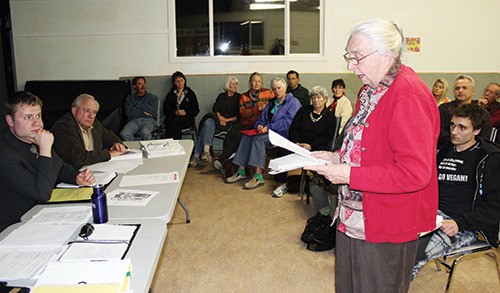For many, it was a matter of “where” rather than “what”.
While most in a packed crowd of more than 170 at the Windermere Community Hall see the need for a small-scale slaughterhouse in the valley, arguments for and against a zoning change that would allow it to be built near the crossroads of Athalmer Road and Highway 93/95 carried on for nearly three hours.
A gentle wind blew from the north as residents from around the valley filed into the hall at 7 p.m. on Wednesday, April 24th. The Windermere District Farmers Institute began by explaining why they are pursuing a micro-abattoir — a small-scale slaughterhouse — to be built on 9.2 hectares (roughly 20 acres) of property they own on the southwest corner of the intersection.
“The intent of this thing is a small-scale micro-abattoir,” said John Zehnder of the Farmers Institute, who compared the abattoir concept to one found within an urban area in Duchess, Alberta, and to small abattoirs in Summerland and Enderby in B.C.
“We’re not trying to create one of these monster plants out in Alberta,” he added. “No tanneries, nothing crazy.”
The facility itself would consist of a 1,000 to 1,700 square foot abattoir building and a livestock storage area, covering a combined 0.8 hectares. It would process five to six animals per day twice a week during peak periods in the fall and the spring.
The lot is set back about 300 metres from Highway 93/95, with a BC Hydro substation being the closest structure to the site. Also nearby is the RCMP detachment building, a Regional District building and the Town and Country Feed Store.
Many of the concerns arose from residents in the nearest residential building, the Black Forest Heights condominiums on the east side of the intersection, who expressed their concerns about what they said was a lack of notice about the proposal. Nearby businesses including the Crossroads Collective and the Copper Point Golf Course also had plenty of questions.
“The District of Invermere needs to have an entrance that’s good,” said Crossroads Collective gallery owner Jessie Blakely, who opened the night’s question period by asking why the abattoir needs to be in such a high-profile location. Mr. Zehnder replied the Farmer’s Institute looked at five sites before determining the three-phase electricity, access to water and central location made the current site the best choice.
The Farmers Institute has owned the lot since the early 1970s, he said, adding the lot itself is within B.C.’s Agricultural Land Reserve, and has received permission for non-farm use.
The public hearing was required for a proposed text amendment to the Upper Columbia Valley zoning bylaw. A text amendment to the rural residential (A-2) zoning would allow that kind of zoning to include an abattoir.
In response to several questions asked by a Copper Point Golf Course representative, Mr. Zehnder explained the bylaw doesn’t restrict how many animals can be killed, how long they can be stored at the site, or what kind of animals can be processed.
Regional district board members will consider granting third and final reading to the zoning amendment on Friday, May 3rd, at which time they may also consider what specific restrictions need to accompany the zoning.
The proposed building would be a frame building with metal cladding, though that could change.
